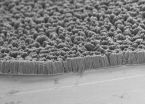(Press-News.org) Polymer materials are usually thermal insulators. But by harnessing an electropolymerization process to produce aligned arrays of polymer nanofibers, researchers have developed a thermal interface material able to conduct heat 20 times better than the original polymer. The modified material can reliably operate at temperatures of up to 200 degrees Celsius.
The new thermal interface material could be used to draw heat away from electronic devices in servers, automobiles, high-brightness LEDs and certain mobile devices. The material is fabricated on heat sinks and heat spreaders and adheres well to devices, potentially avoiding the reliability challenges caused by differential expansion in other thermally-conducting materials.
"Thermal management schemes can get more complicated as devices get smaller," said Baratunde Cola, an assistant professor in the George W. Woodruff School of Mechanical Engineering at the Georgia Institute of Technology. "A material like this, which could also offer higher reliability, could be attractive for addressing thermal management issues. This material could ultimately allow us to design electronic systems in different ways."
The research, which was supported by the National Science Foundation, was reported March 30 in the advance online publication of the journal Nature Nanotechnology. The project involved researchers from the Georgia Institute of Technology, University of Texas at Austin, and the Raytheon Company. Virendra Singh, a research scientist in the Woodruff School, and Thomas Bougher, a Ph.D. student in the Woodruff School, are the paper's co-first authors.
Amorphous polymer materials are poor thermal conductors because their disordered state limits the transfer of heat-conducting phonons. That transfer can be improved by creating aligned crystalline structures in the polymers, but those structures – formed through a fiber drawing processes – can leave the material brittle and easily fractured as devices expand and contract during heating and cooling cycles.
The new interface material is produced from a conjugated polymer, polythiophene, in which aligned polymer chains in nanofibers facilitate the transfer of phonons – but without the brittleness associated with crystalline structures, Cola explained. Formation of the nanofibers produces an amorphous material with thermal conductivity of up to 4.4 watts per meter Kelvin at room temperature.
The material has been tested up to 200 degrees Celsius, a temperature that could make it useful for applications in vehicles. Solder materials have been used for thermal interfaces between chips and heat sinks, but may not be reliable when operated close to their reflow temperatures.
"Polymers aren't typically thought of for these applications because they normally degrade at such a low temperature," Cola explained. "But these conjugated polymers are already used in solar cells and electronic devices, and can also work as thermal materials. We are taking advantage of the fact that they have a higher thermal stability because the bonding is stronger than in typical polymers."
The structures are grown in a multi-step process that begins with an alumina template containing tiny pores covered by an electrolyte containing monomer precursors. When an electrical potential is applied to the template, electrodes at the base of each pore attract the monomers and begin forming hollow nanofibers. The amount of current applied and the growth time control the length of the fibers and the thickness of their walls, while the pore size controls the diameter. Fiber diameters range from 18 to 300 nanometers, depending on the pore template.
After formation of the monomer chains, the nanofibers are cross-linked with an electropolymerization process, and the template removed. The resulting structure can be attached to electronic devices through the application of a liquid such as water or a solvent, which spreads the fibers and creates adhesion through capillary action and van der Waals forces.
"With the electrochemical polymerization processing approach that we took, we were able to align the chains of the polymer, and the template appears to prevent the chains from folding into crystals so the material remained amorphous," Cola explained. "Even though our material is amorphous from a crystalline standpoint, the polymer chains are highly aligned – about 40 percent in some of our samples."
Though the technique still requires further development and is not fully understood theoretically, Cola believes it could be scaled up for manufacturing and commercialization. The new material could allow reliable thermal interfaces as thin as three microns – compared to as much as 50 to 75 microns with conventional materials.
"There are some challenges with our solution, but the process is inherently scalable in a fashion similar to electroplating," he said. "This material is well known for its other applications, but ours is a different use."
Engineers have been searching for an improved thermal interface material that could help remove heat from electronic devices. The problem of removing heat has worsened as devices have gotten both smaller and more powerful.
Rather than pursue materials because of their high thermal conductivity, Cola and his collaborators investigated materials that could provide higher levels of contact in the interface. That's because in some of the best thermal interface materials, less than one percent of the material was actually making contact.
"I stopped thinking so much about the thermal conductivity of the materials and started thinking about what kinds of materials make really good contact in an interface," Cola said. He decided to pursue polythiophene materials after reading a paper describing a "gecko foot" application in which the material provided an estimated 80 percent contact.
Samples of the material have been tested to 200 degrees Celsius through 80 thermal cycles without any detectable difference in performance. While further work will be necessary to understand the mechanism, Cola believes the robustness results from adhesion of the polymer rather than a bonding.
"We can have contact without a permanent bond being formed," he said. "It's not permanent, so it has a built-in stress accommodation. It slides along and lets the stress from thermal cycling relax out."
In addition to those already mentioned, co-authors of the paper included Professor Kenneth Sandhage, Research Scientist Ye Cai, Assistant Professor Asegun Henry and graduate assistant Wei Lv of Georgia Tech; Prof. Li Shi, Annie Weathers, Kedong Bi, Micheal T. Pettes and Sally McMenamin in the Department of Mechanical Engineering at the University of Texas at Austin; and Daniel P. Resler, Todd Gattuso and David Altman of the Raytheon Company.
A patent application has been filed on the material. Cola has formed a startup company, Carbice Nanotechnologies, to commercialize thermal interface technologies. It is a member of Georgia Tech's VentureLab program.
INFORMATION:
This research was supported by the National Science Foundation (NSF) through award CBET-113071, a seed grant from the Georgia Tech Center for Organic Photonics and Electronics and an NSF-IGERT graduate fellowship. Any conclusions or opinions are those of the authors and do not necessarily represent the official views of the NSF.
CITATION: Virenda Singh, et al., "High thermal conductivity of chain-oriented amorphous polythiophene," (Nature Nanotechnology, 2014). http://www.dx.doi.org/10.1038/nnano.2014.44
Heat-conducting polymer cools hot electronic devices at 200 degrees C
2014-03-30
ELSE PRESS RELEASES FROM THIS DATE:
Scientists pinpoint why we miss subtle visual changes, and why it keeps us sane
2014-03-30
Ever notice how Harry Potter's T-shirt abruptly changes from a crewneck to a henley shirt in "The Order of the Phoenix," or how in "Pretty Woman," Julia Roberts' croissant inexplicably morphs into a pancake? Don't worry if you missed those continuity bloopers. Vision scientists at the University of California, Berkeley, and the Massachusetts Institute of Technology have discovered an upside to the brain mechanism that can blind us to subtle changes in movies and in the real world.
They've discovered a "continuity field" in which the brain visually merges similar objects ...
A new approach to Huntington's disease?
2014-03-30
Tweaking a specific cell type's ability to absorb potassium in the brain improved walking and prolonged survival in a mouse model of Huntington's disease, reports a UCLA study published March 30 in the online edition of Nature Neuroscience. The discovery could point to new drug targets for treating the devastating disease, which strikes one in every 20,000 Americans.
Huntington's disease is passed from parent to child through a mutation in the huntingtin gene. By killing brain cells called neurons, the progressive disorder gradually deprives patients of their ability ...
Erasing a genetic mutation
2014-03-30
CAMBRIDGE, MA -- Using a new gene-editing system based on bacterial proteins, MIT researchers have cured mice of a rare liver disorder caused by a single genetic mutation.
The findings, described in the March 30 issue of Nature Biotechnology, offer the first evidence that this gene-editing technique, known as CRISPR, can reverse disease symptoms in living animals. CRISPR, which offers an easy way to snip out mutated DNA and replace it with the correct sequence, holds potential for treating many genetic disorders, according to the research team.
"What's exciting about ...
Effect of important air pollutants may be absent from key precipitation observations
2014-03-30
Pioneering new research from the University of Exeter could have a major impact on climate and environmental science by drastically transforming the perceived reliability of key observations of precipitation, which includes rain, sleet and snow.
The ground breaking study examines the effect that increased aerosol concentrations in the atmosphere, emitted as a result of burning fossil fuels, had on regional temperature and precipitation levels.
Scientists from Exeter's Mathematics department compared observed regional temperature and precipitation changes throughout ...
Genetic mutations warn of skin cancer risk
2014-03-30
Researchers have discovered that mutations in a specific gene are responsible for a hereditary form of melanoma.
Every year in the UK, almost 12,000 people are diagnosed with melanoma, a form of skin cancer. About 1 in 20 people with melanoma have a strong family history of the disease. In these patients, pinpointing the genetic mutations that drive disease development allows dermatologists to identify people who should be part of melanoma surveillance programmes.
The team found that people with specific mutations in the POT1 gene were extremely likely to develop melanoma. ...
Scripps Florida scientists offer 'best practices' nutrition measurement for researchers
2014-03-30
JUPITER, FL, March 30, 2014 – At first glance, measuring what the common fruit fly eats might seem like a trivial matter, but it is absolutely critical when it comes to conducting studies of aging, health, metabolism and disease. How researchers measure consumption can make all the difference in the accuracy of a study's conclusions.
Scientists from the Florida campus of The Scripps Research Institute (TSRI) have developed what amounts to a best practices guide to the most accurate way of measuring fruit fly food consumption that could lead to more informed research and ...
Researchers identify new protein markers that may improve understanding of heart disease
2014-03-30
Researchers at the Intermountain Medical Center Heart Institute in Murray, Utah, have discovered that elevated levels of two recently identified proteins in the body are inflammatory markers and indicators of the presence of cardiovascular disease.
These newly identified markers of inflammation, GlycA and GlycB, have the potential to contribute to better understanding of the inflammatory origins of heart disease and may be used in the future to identify a heart patient's future risk of suffering a heart attack, stroke, or even death.
Inflammation occurs in the body ...
Study compares heart valve systems
2014-03-30
Among patients undergoing aortic valve replacement using a catheter tube, a comparison of two types of heart valve technologies, balloon-expandable or self-expandable valve systems, found a greater rate of device success with the balloon-expandable valve, according to a JAMA study released online to coincide with presentation at the 2014 American College of Cardiology Scientific Sessions.
Transcatheter aortic valve replacement (TAVR) has emerged as a new option for patients with severe narrowing of the aortic valve and as an effective alternative treatment method to ...
Medication does not reduce risk of recurrent CV events among patients with diabetes
2014-03-30
Use of the drug aleglitazar, which has shown the ability to lower glucose levels and have favorable effects on cholesterol, did not reduce the risk of cardiovascular death, heart attack or stroke among patients with type 2 diabetes and recent heart attack or unstable angina, according to a JAMA study released online to coincide with presentation at the 2014 American College of Cardiology Scientific Sessions.
Cardiovascular disease remains the dominant cause of death among patients with type 2 diabetes. No drug therapy specifically directed against diabetes nor strategy ...
Puritas Beverages Sponsors Lauren Mayhew and Her "What Is Love" Video To Air On Fox Sports, April 9
2014-03-30
Puritas Organic Gold, the official hydration sponsor of actress/singer/TV personality Lauren Mayhew, announces her "WHAT IS LOVE" video will debut on FOX Sports homepage April 8th, and be televised nationwide on April 9th on FOX's "UFC Tonight."
Puritas Organic Gold is the only USDA certified organic fulvic-infused, naturally stable 9.5pH high alkaline water, which meets or exceeds standards for kosher and vegan, contains more than 77 trace minerals and provides superior hydration.
"We are thrilled to be able to support Lauren Mayhew's newest video, while also increasing ...


